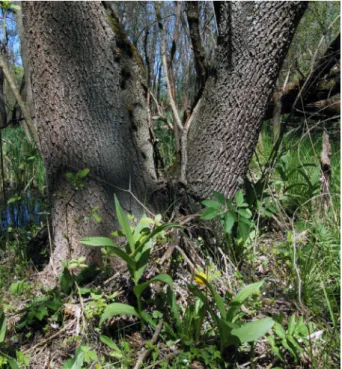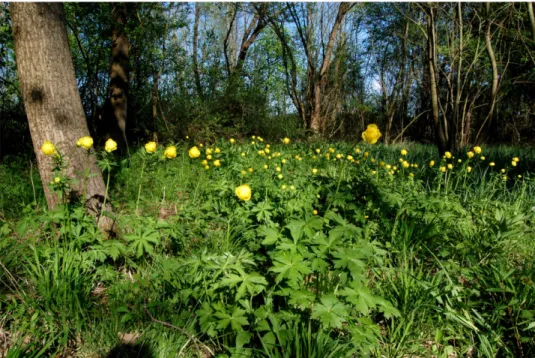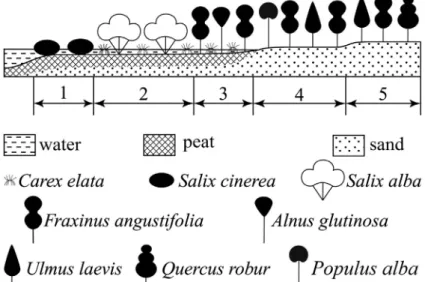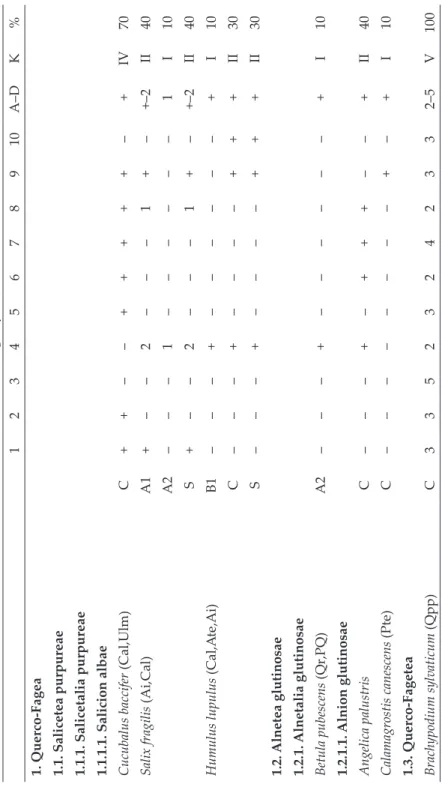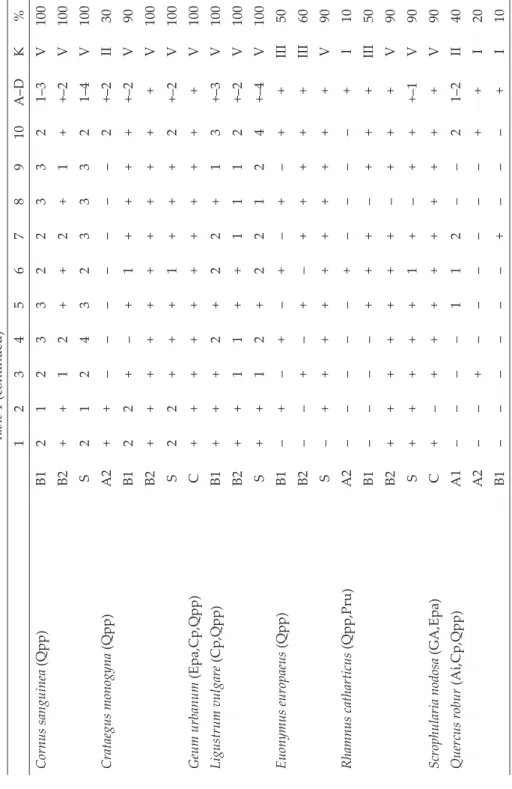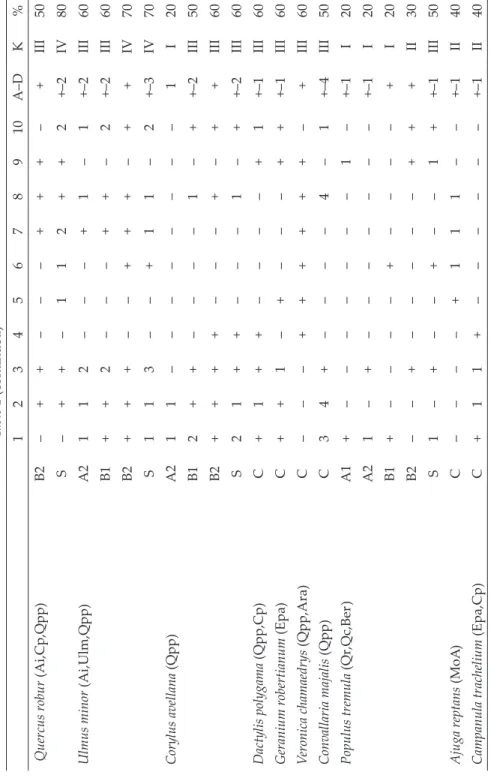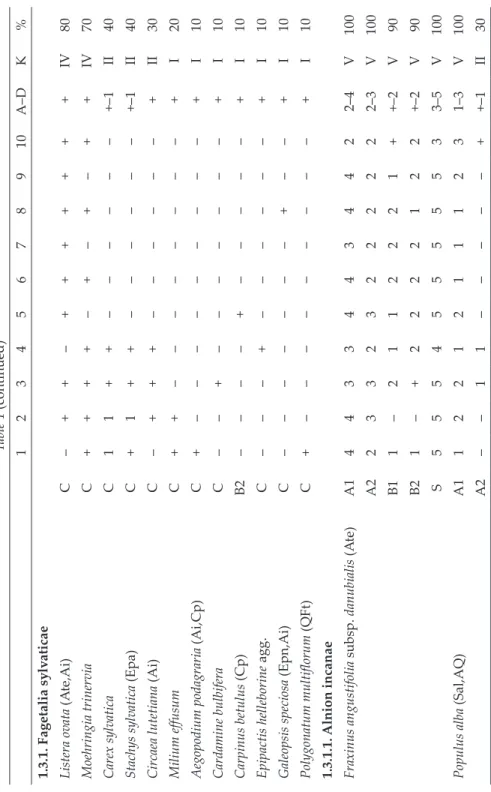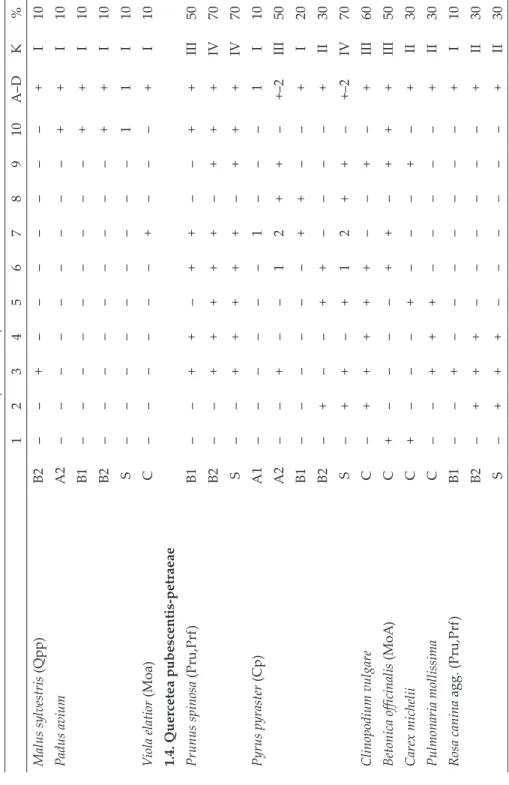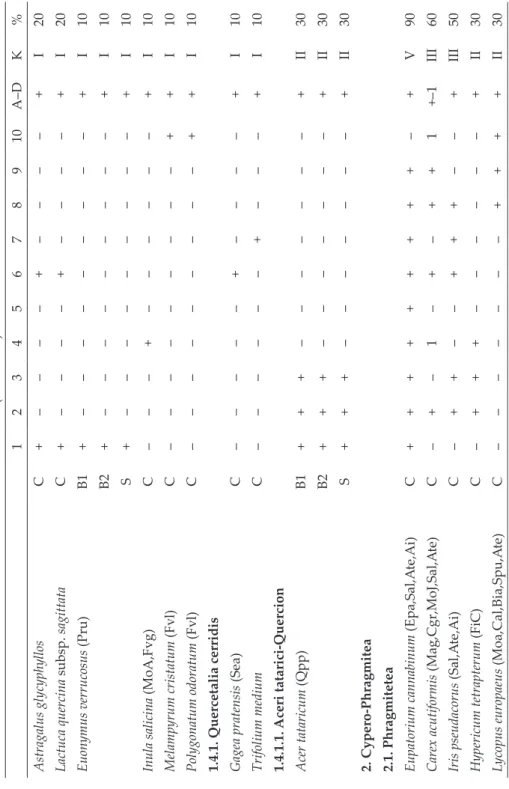DRAINED ASH SWAMP
(VERATRO ALBI-FRAXINETUM ANGUSTIFOLIAE), A NEW ASSOCIATION IN THE NYÍRSÉG, NE HUNGARY
B. Kevey1, L. Papp2 and G. Lendvai3
1Department of Ecology, University of Pécs, H-7624 Pécs, Ifjúság u. 6, Hungary E-mail: keveyb@gamma.ttk.pte.hu
2Botanical Garden, University of Debrecen, H-4032 Debrecen, Egyetem tér 1, Hungary E-mail: papp.laszlo@gf.unideb.hu
3H-7000 Sárbogárd, Tompa Mihály u. 38/C, Hungary; E-mail: gaborlendvai@hotmail.com
(Received 29 March, 2017; Accepted 8 August, 2018)
This paper presents the phytosociological description of a drained swamp community, Veratro albi-Fraxinetum angustifoliae, so far found only in the Nyírség at Nyírábrány “Kis- kőrises”, “Mogyorósi-erdő”; Vámospércs “Jónásrész-Kőrises”; and Vámospércs “Jónás- rész-Buzita”. The habitat of the community is transitional between that of alder swamps (Fraxino pannonicae-Alnetum glutinosae), and hardwood riparian forests (Fraxino pannoni- cae-Ulmetum). The community is characterised by high proportions of character species of Alnion glutinosae and Molinion coerulei as well as Quercetea pubescentis-petraeae s.
l., whereas character species of the order Fagetalia are almost completely absent. It hosts several rare, often threatened species, such as Angelica palustris, Ophioglossum vulgatum, Trollius europaeus and Veratrum album.
Key words: ash swamp, Great Hungarian Plain, Natura 2000, nature reserve, syntaxonomy
INTRODUCTION
Hardwood riparian forests have been the subject of our long-term re- search on the distribution, composition and geographical variation of the forest vegetation in Hungary. Hardwood riparian forests still occur in most lowland areas of Hungary under different environmental conditions and thus are particularly suitable for studying phytosociological differentiation and biogeographical relationships in the forest vegetation within the Carpathian Basin. During our work in the Nyírség, an extensive area in the northeastern part of Hungary covered with eolic sand, we found several Fraxinus angus- tifolia dominated forest stands that seemed to be different from all known forest communities described previously in the country (Figs 1–2). No similar forest community is known to exist in the European vegetation either (Braun- Blanquet 1964, Ellenberg 1986, Horvat 1938, Horvat et al. 1974, Mucina et al.
1993, Oberdorfer 1992a, b, Rodwell et al. 2002, Willner and Grabherr 2007a, b).
Because their species composition appeared to be substantially differ-
1963, a community once widely distributed in similarly moist habitats across the country, and Fraxino pannonicae-Alnetum Soó et Járai-Komlódi in Járai- Komlódi 1958, we described it as a novel association under the name Veratro albi-Fraxinetum angustifoliae Kevey et Papp L. (Kevey 2008).
Unfortunately, this association has not been described in more detail, nor has a synoptic table of it been published since then. Here we are going to fill this gap by providing a detailed description of the community based on our sample material of ten relevés. Our primary goal is to substantiate the split of this new association from the rest of the hardwood riparian forests found in Hungary.
MATERIAL AND METHODS Research area
The studied Fraxinus angustifolia dominated stands were found in four different forest areas in the Nyírség: the Mogyorósi-erdő and Kis-kőrises near the town of Nyírábrány, and the Jónásrész-Kőrises and Jónásrész-Buzita near the village of Nyíracsád. The stands were all found along the edge of local
Fig. 1. Veratro albi-Fraxinetum angustifoliae: Vámospércs “Jónásrész” with Veratrum album in the foreground (photo: L. Papp)
depressions where the habitat is characterised by high groundwater levels, which rises above the ground surface only in very wet periods. They either grow at the fringe of genuine alder swamps (Fraxino pannonicae-Alnetum) in the deepest parts of local depressions, or form the transition zone between these swamps and oak-ash-elm forests (Fraxino pannonicae-Ulmetum) growing on higher ground (Fig. 3). Since the ground is normally not covered with wa- ter throughout most of the vegetative period in their habitats, the soil contains only small amounts of peat that is generally decaying.
The three studied forest areas are all parts of the Natura 2000 network, and are also protected by national law. The Jónásrész “Kőrises” and “Buzita”, and “Kis-kőrises” are state reserves, whereas the “Mogyorósi-erdő” is under strict protection.
Methods
Our sampling procedure followed the traditional quadrate method of the Zürich-Montpellier phytosociological school (Becking 1957, Braun-Blan- quet 1964). Sample plots were designated visually by selecting the parts of a stand that seemed to be the most homogeneous in habitat characteristics,
Fig. 2. Veratro albi-Fraxinetum angustifoliae: Vámospércs “Jónásrész” with Trollius europaeus in the herb layer (photo: L. Papp)
vegetation structure and species composition, and showed no signs of hu- man impact (including forest management). Because the traditionally used 400 m
2plot size does not satisfy the requirement for minimal area (see Du Rietz 1921), our sample plots were 1600 m
2in size except for one (1200 m
2).
This size suffices the requirement of representativity in temperate deciduous forests (Kevey 2008).
Because forests in similarly mesic habitats tend to exhibit large phenologi- cal changes during the vegetative period, we sampled each stand twice (spring and summer) using the same plots. During sampling, we recorded all species within the sample quadrate and estimated their projected cover. We also esti- mated the height of each vegetation layer, and the trunk diameter of trees.
The raw data were compiled and arranged in a synoptic table by the NS software program (Kevey and Hirmann 2002), which also was used to calcu- late constancy values of each species, and proportions of species characteristic of a particular syntaxon. To assess the syntaxonomic relationship of the stud- ied stands, we compared them to a representative material of the spatially adjacent Fraxino pannonicae-Alnetum and Fraxino pannonicae-Ulmetum, and all previously described communities growing in similar habitats in Hungary:
Ophioglosso-Betuletum pubescentis (Vértesalja: Riezing and Szollát 2008–2009:
6 relevés); Molinio-Alnetum glutinosae (Tengelici-homokvidék: Kevey 2008: 20 relevés); Molinio-Salicetum cinereae (Szigetköz: Kevey 2008: 25 relevés). In do- ing so, we performed pairwise comparisons between sample sets and deter-
Fig. 3. Vegetation diagram of the “Mogyorósi-erdő” at Nyírábrány. 1 = Calamagrostio-Sali- cetum cinereae; 2 = Carici elatae-Salicetum albae; 3 = Fraxino pannonicae-Alnetum glutinosae; 4 =
Veratro albi-Fraxinetum angustifoliae; 5: Fraxino pannonicae-Ulmetum. (Kevey original)
mined the set of differential species (species that differed in their constancy value by at least two steps) and the proportions of character species. We also carried out binary cluster and principal coordinates analyses (PCoA) with the help of the Syntax 2000 package (Podani 2001). The method of grouping in the cluster analyses was complete link, and the similarity coefficient in both types of analyses was that of Baroni-Urbani and Buser.
The names of plants and syntaxonomic categories follow the nomenclature of Király (2009) and that of Borhidi and Kevey (1996), Borhidi et al. (2012), and Kevey (2008), respectively. Designation of species as character species of phy- tosociological taxa is primarily adopted from Soó (1964, 1966, 1968, 1970, 1973, 1980) with some modifications based on more recent literature (see Borhidi 1993, 1995, Horváth et al. 1995) and our own research experience (Kevey ined.).
The order of syntaxa in the synoptic and statistical tables follows the modified syntaxonomic system of Soó (1980) according to the suggestions and results of Borhidi et al. (2012), Kevey (2008), Mucina et al. (1993) and Ober- dorfer (1992a, b).
RESULTS Physiognomy and structure
In the studied stands, the forest canopy was structured into two distinct layers. The upper layer was situated at about 20–28 m height and was rather dense with high (60–80%) projected cover. The most abundant (A–D: 3–4) tree species in this layer were Fraxinus angustifolia subsp. danubialis and Populus alba. They were also constant species across the samples.
The lower canopy layer was at the height of 12–20 m. The projected cov- er was rather variable among samples. It was made up of mostly tree-sized shrubs and young individuals of trees. The most abundant species in this lay- er was Fraxinus angustifolia subsp. danubialis.
Shrubs in the samples were 1.5–3.5 m tall, and formed a moderately dense layer with 25–70% cover value. It was composed of Cornus sanguinea, Crataegus monogyna, Frangula alnus, Fraxinus angustifolia subsp. danubialis, and Ligustrum vulgare. Only Cornus sanguinea and Ligustrum vulgare had rather high cover values. The layer of saplings was greatly variable in projected cover (1–50%).
All samples had an apparent herbaceous layer, which greatly varied in
cover (35–85%). The most frequent species include Angelica sylvestris, Brachy-
podium sylvaticum, Cucubalus baccifer, Filipendula ulmaria, Geranium palustre,
Listera ovata, Lychnis flos-cuculi, Lysimachia nummularia, Moehringia trinervia,
Poa trivialis, Scrophularia nodosa, Valeriana officinalis, Veratrum album. Only two
species (Brachypodium sylvaticum and Convallaria majalis) were locally abun-
dant at places (Table 1).
Table 1 Veratro albi-Fraxinetum angustifoliae 12345678910A–DK% 1. Querco-Fagea 1.1. Salicetea purpureae 1.1.1. Salicetalia purpureae 1.1.1.1. Salicion albae Cucubalus baccifer (Cal,Ulm) C ++––+++++– + IV70 Salix fragilis (Ai,Cal) A1+––2–––1+–+–2II40 A2–––1–––––– 1 I10 S +––2–––1+–+–2II40 Humulus lupulus (Cal,Ate,Ai) B1–––+–––––– + I10 C –––+––––++ + II30 S –––+––––++ + II30 1.2. Alnetea glutinosae 1.2.1. Alnetalia glutinosae Betula pubescens (Qr,PQ) A2–––+–––––– + I10 1.2.1.1. Alnion glutinosae Angelica palustris C –––+–+++–– + II40 Calamagrostis canescens (Pte) C ––––––––+– + I10 1.3. Querco-Fagetea Brachypodium sylvaticum (Qpp) C 33523242332–5V100
Table 1 (continued) 12345678910A–DK% Cornus sanguinea (Qpp) B121233223321–3V100 B2++12++2+1++–2V100 S 21243233321–4V100 Crataegus monogyna (Qpp) A2++–––––––2+–2II30 B122+–+1+++++–2V90 B2++++++++++ + V100 S 22+++1+++2+–2V100 Geum urbanum (Epa,Cp,Qpp) C ++++++++++ + V100 Ligustrum vulgare (Cp,Qpp) B1+++2+22+13+–3V100 B2++11++1112+–2V100 S ++12+22124+–4V100 Euonymus europaeus (Qpp) B1–+–+–+–+–+ + III50 B2––+–+–++++ + III60 S –+++++++++ + V90 Rhamnus catharticus (Qpp,Pru) A2–––––+–––– + I10 B1––––+++–++ + III50 B2+++++++–++ + V90 S +++++1+–+++–1V90 Scrophularia nodosa (GA,Epa) C +–++++++++ + V90 Quercus robur (Ai,Cp,Qpp) A1––––112––21–2II40 A2––+––––––+ + I20 B1––––––+––– + I10
Table 1 (continued) 12345678910A–DK% Quercus robur (Ai,Cp,Qpp)B2–++–––+++– + III50 S –++–112++2+–2IV80 Ulmus minor (Ai,Ulm,Qpp) A2112–––+1–1+–2III60 B1++2–––++–2+–2III60 B2+++––+++–+ + IV70 S 113––+11–2+–3IV70 Corylus avellana (Qpp) A211–––––––– 1 I20 B12++––––1–++–2III50 B2++++–––+–+ + III60 S 21++–––1–++–2III60 Dactylis polygama (Qpp,Cp) C +1++––––+1+–1III60 Geranium robertianum (Epa) C ++1–+–––+++–1III60 Veronica chamaedrys (Qpp,Ara) C –––++++++– + III60 Convallaria majalis (Qpp) C 34+––––4–1+–4III50 Populus tremula (Qr,Qc,Ber) A1+–––––––1–+–1I20 A21–+–––––––+–1I20 B1+––––+–––– + I20 B2––+–––––++ + II30 S 1–+––+––1++–1III50 Ajuga reptans (MoA) C ––––+111––+–1II40 Campanula trachelium (Epa,Cp) C +11+––––––+–1II40
Table 1 (continued) 12345678910A–DK% Carex spicata (Qpp,Epa) C ––++––+–+– + II40 Heracleum sphondylium (Qpp,MoA) C ++++–––––– + II40 Polygonatum latifolium (Qpp) C ++––––––++ + II40 Cruciata glabra C +++––––––– + II30 Ranunculus auricomus agg. (MoA) C ––––––++–+ + II30 Carex divulsa C –––––––+–+ + I20 Fragaria vesca (Qpp,Epa) C ––––+–––+– + I20 Galeopsis pubescens (Qpp,Epa) C ––––+–––+– + I20 Veronica hederifolia subsp. lucorumC –++––––––– + I20 Acer campestre (Qpp) A21––––––––– 1 I10 B1+––––––––– + I10 B2+––––––––– + I10 S 1––––––––– 1 I10 Cephalanthera damasonium (Qpp) C ––––+––––– + I10 Cephalanthera longifolia C ––––+––––– + I10 Lapsana communis (Qpp,GA,Epa) C +––––––––– + I10 Mycelis muralis C ––––+––––– + I10 Platanthera bifolia (Qpp,PQ,NC,Moa) C ––––+––––– + I10 Poa nemoralis (Qpp) C +––––––––– + I10 Vicia sepium (Ara,Qpp) C ––––––+––– + I10 Viola mirabilis (F,Qpp) C +––––––––– + I10
Table 1 (continued) 12345678910A–DK% 1.3.1. Fagetalia sylvaticae Listera ovata (Ate,Ai) C –++–++++++ + IV80 Moehringia trinervia C ++++–+–+–+ + IV70 Carex sylvatica C 11++––––––+–1II40 Stachys sylvatica (Epa) C +1++––––––+–1II40 Circaea lutetiana (Ai) C –+++–––––– + II30 Milium effusum C ++–––––––– + I20 Aegopodium podagraria (Ai,Cp) C +––––––––– + I10 Cardamine bulbifera C ––+––––––– + I10 Carpinus betulus (Cp) B2––––+––––– + I10 Epipactis helleborine agg. C –––+–––––– + I10 Galeopsis speciosa (Epn,Ai) C –––––––+–– + I10 Polygonatum multiflorum (QFt) C +––––––––– + I10 1.3.1.1. Alnion incanae Fraxinus angustifolia subsp. danubialis (Ate) A144334434422–4V100 A223323222222–3V100 B11–2112221++–2V90 B21–+2222122+–2V90 S 55545555533–5V100 Populus alba (Sal,AQ) A112212111231–3V100 A2––11–––––++–1II30
Table 1 (continued) 12345678910A–DK% Populus alba (Sal,AQ)B1+––––––––+ + I20 B2+–++–+++++ + IV80 S 12222111231–3V100 Viburnum opulus (Ate) B1–––1–––––++–1I20 B2+++1+++++1+–1V100 S +++2+++++1+–2V100 Frangula alnus (Ate,Qr,PQ) B1–+++++––++ + IV70 B2––+–++++++ + IV70 S –+++++++++ + V90 Elymus caninus (Pna,Qpp) C +++++––––+ + III60 Festuca gigantea (Cal,Epa) C –++–––1––++–1II40 Rumex sanguineus (Epa,Pna) C +–+––––––+ + II30 Carex remota C +––––––––+ + I20 Equisetum hyemale (F) C +––––––––+ + I20 Ribes rubrum B1–––––––––+ + I10 B2–+–––––––– + I10 S –+–––––––+ + I20 Ulmus laevis (Sal,Ulm) A1–––––+–––2+–2I20 A2–––––––––+ + I10 B1–––––––––+ + I10 B2–––––+–––– + I10 S –––––+–––2+–2I20
Table 1 (continued) 12345678910A–DK% Malus sylvestris (Qpp) B2––+––––––– + I10 Padus avium A2–––––––––+ + I10 B1–––––––––+ + I10 B2–––––––––+ + I10 S –––––––––1 1 I10 Viola elatior (Moa) C ––––––+––– + I10 1.4. Quercetea pubescentis-petraeae Prunus spinosa (Pru,Prf) B1––++–++––+ + III50 B2––+++++–++ + IV70 S ––+++++–++ + IV70 Pyrus pyraster (Cp) A1––––––1––– 1 I10 A2––+––12++–+–2III50 B1––––––++–– + I20 B2–+––++–––– + II30 S –++–+12++–+–2IV70 Clinopodium vulgare C –+++++––+– + III60 Betonica officinalis (MoA) C +––––++–++ + III50 Carex michelii C +–––+–––+– + II30 Pulmonaria mollissima C ––+++––––– + II30 Rosa canina agg. (Pru,Prf) B1––+––––––– + I10 B2–+++–––––– + II30 S –+++–––––– + II30
Table 1 (continued) 12345678910A–DK% Astragalus glycyphyllos C +––––+–––– + I20 Lactuca quercina subsp. sagittataC +––––+–––– + I20 Euonymus verrucosus (Pru) B1+––––––––– + I10 B2+––––––––– + I10 S +––––––––– + I10 Inula salicina (MoA,Fvg) C –––+–––––– + I10 Melampyrum cristatum (Fvl) C –––––––––+ + I10 Polygonatum odoratum (Fvl) C –––––––––+ + I10 1.4.1. Quercetalia cerridis Gagea pratensis (Sea) C –––––+–––– + I10 Trifolium medium C ––––––+––– + I10 1.4.1.1. Aceri tatarici-Quercion Acer tataricum (Qpp) B1+++––––––– + II30 B2+++––––––– + II30 S +++––––––– + II30 2. Cypero-Phragmitea 2.1. Phragmitetea Eupatorium cannabinum (Epa,Sal,Ate,Ai) C +++++++++– + V90 Carex acutiformis (Mag,Cgr,MoJ,Sal,Ate) C –+–1–+–++1+–1III60 Iris pseudacorus (Sal,Ate,Ai) C –++––+++–– + III50 Hypericum tetrapterum (FiC) C –+++–––––– + II30 Lycopus europaeus (Moa,Cal,Bia,Spu,Ate) C –––––––+++ + II30
Table 1 (continued) 12345678910A–DK% Sium latifolium (Sal,Ate) C ––+–––––1++–1II30 Solanum dulcamara (Cal,Bia,Spu) C +–+1––––––+–1II30 Galium palustre (Mag,MoJ,FPi,Spu,Ate) C –––+––––+– + I20 Carex riparia (Mag,Cgr,MoJ,Sal,Ate) C ––––––––+– + I10 Epilobium parviflorum (NG,MoJ,Moa,Ate) C ––––––––+– + I10 Euphorbia palustris (Mag,Des,FiC,Bec,Ate) C –––––––––+ + I10 Stachys palustris (Moa,Cal,Bin,Spu,Ate) C –––+–––––– + I10 2.1.1. Nasturtio-Glycerietalia 2.1.1.1. Glycerio-Sparganion Scrophularia umbrosa (Ai) C –––+–––––– + I10 2.1.2. Magnocaricetalia 2.1.2.1. Magnocaricion Carex otrubae (Cgr,MoJ,FPi,Ai) C ––+––––++– + II30 3. Molinio-Arrhenatherea Lychnis flos-cuculi (Mag,Ate) C –+++++++++ + V90 Poa trivialis (Pte,Spu,Ate,Ai) C ++++–+++–– + IV70 Cardamine pratensis (Mag,Des,Sal,Ate,Ai) C ––+–––+++– + II40 Vicia cracca (Mag,Sea,Aon,Qpp) C ––++––+––– + II30 Lathyrus pratensis (Mag,Qpp) C ––––––+–+– + I20 Ranunculus acris C ––––++–––– + I20 Pastinaca sativa (Arn) C –––––––––+ + I10
Table 1 (continued) 12345678910A–DK% 3.1. Molinio-Juncetea Veratrum album (Ate,Ai) C +++–+2+211+–2V90 Cirsium canum (Mag,Ate,Ai) C ––+++–+–++ + III60 Deschampsia caespitosa (Des,Sal,Ate,Ai) C ––––+211+++–2III60 Cirsium rivulare (Mag,Ate,Ai) C –+++––––+– + II40 Symphytum officinale (Pte,Cal,Spu,Ate,Ai) C –––+––+–++ + II40 Selinum carvifolia (Mon,Ate,PQ) C ––––+–––+– + I20 Succisa pratensis (Mon,Tof,NC) C –––––––––+ + I10 3.1.1. Molinietalia coeruleae Angelica sylvestris (Mag,Ate,Ai) C ++1++++++++–1V100 Valeriana officinalis (Mag,FiC) C –––+++++++ + IV70 Ophioglossum vulgatum (NC,Arn) C ––––++++++ + III60 Trollius europaeus (Ate) C –+–+–++++– + III60 Orchis militaris (FBt,Qpp) C ––––++–––– + I20 3.1.1.1. Filipendulo-Cirsion oleracei Filipendula ulmaria (Moa,Sal,Ate,Ai) C ++11+++++++–1V100 Geranium palustre (Ate) C ++1+++++––+–1IV80 4. Festuco-Bromea Campanula glomerata (Qpp) C –––+––+–+– + II30 5. Chenopodio-Scleranthea 5.1. Secalietea Muscari comosum (FBt) C ––––––––+– + I10
Table 1 (continued) 12345678910A–DK% 5.2. Chenopodietea Arctium minus (Ar,Bia,Pla) C +–+––+–++– + III50 5.3. Galio-Urticetea 5.3.1. Calystegietalia sepium 5.3.1.1. Galio-Alliarion Chaerophyllum temulum C ++–+1––++–+–1III60 Alliaria petiolata (Epa) C ––––++–+–– + II30 5.3.1.2. Calystegion sepium Myosoton aquaticum (Pte,Spu,Ate,Ai) C –+–+–––––– + I20 Bryonia alba (Ar,GA) C ––+––––––– + I10 Calystegia sepium (Pte,Bia,Pla,Spu,Ate) C –––––––––+ + I10 5.4. Epilobietea angustifolii 5.4.1. Epilobietalia Galeopsis bifida (Cal) C ––+––––––– + I10 Salix caprea (US,QFt) A2–––––––––+ + I10 6. Indifferens Equisetum arvense (MoA,Sea,Sal,Ate,Ai) C ++++++++++ + V100 Galium aparine (Sea,Epa,QFt) C +1++++++1++–1V100 Lysimachia nummularia (Pte,MoJ,Bia) C ++++++++1++–1V100 Rubus caesius (Spu) B2++1111–++1+–1V90 Torilis japonica (Ar,GA,Epa,QFt) C +++++++++– + V90 Glechoma hederacea (MoA,QFt,Sal,Ai) C ++11++–++–+–1IV80
Table 1 (continued) 12345678910A–DK% Taraxacum officinale agg. (MoA,ChS) C +–+–+++++– + IV70 Urtica dioica (Ar,GA,Epa,Spu) C –––++++++– + III60 Sambucus nigra (Epa,US,QFt) B2–––+–+–+++ + III50 Caltha palustris (Mag,MoJ,Spu,Ate,Ai) C –++–––––++ + II40 Galium mollugo (MoA,FBt,Qrp,Qpp) C ––++––+––+ + II40 Ranunculus repens (Pte,MoA,ChS,Spu,Ate) C –––+–––+++ + II40 Serratula tinctoria (MoA,MoJ,Qrp,Qpp,PQ) C –––––+––+– + I20 Stellaria media (ChS,QFt,Spu) C –++––––––– + I20 Carex hirta (Pte,MoA,Pla) C –––+–––––– + I10 Lamium album (Ar,GA,Cal) C –––––––+–– + I10 Lysimachia vulgaris (Ai,Pte,SCn,MoJ,Sal) C –––––––––+ + I10 Mentha aquatica (Pte,Moa,Spu,Ate,Ai) C –––––––––+ + I10 Prunella vulgaris (Pte,MoA,ChS,QFt) C ––––––––+– + I10 Pseudolysimachion longifolium (Des,FiC) C ––––––––+– + I10 7. Adventiva Fraxinus pennsylvanica A2––––+2–1––+–2II30 B1––––11+–––+–1II30 B2––––++++–– + II40 S ––––12+1––+–2II40 Acer negundo B1–+–––––––– + I10 B2–++––––––– + I20 S –++––––––– + I20
Frequency distribution of constancy classes The ten samples included 22 constant (K:
V) and 12 sub-constant K: IV) species. The num- ber of accessorial (K: III), sub-accessorial (K: II), and accidental (K: I) species in the samples was 19, 37, and 69, respectively (see Table 1).
Table 1 (continued) 12345678910A–DK% Celtis occidentalis B2––––––––++ + I20 Echinocystis lobata C –+–––––––– + I10 Parthenocissus inserta B2–––––––––1 1 I10 Robinia pseudo-acacia B2––––––+––– + I10 Vitis ripariaB1–––––––––+ + I10 B2–––––––––+ + I10 S –––––––––+ + I10
Fig. 4. Frequency distribution of species in different constancy classes in Veratro albi-
Fraxinetum angustifoliae
Fig. 5. Proportion of Alnetea glutinosae s.
l. character species. Fr-A = Fraxino pannoni- cae-Alnetum, Nyírség (Kevey and Papp L.
ined.: 5 relevés); V-Fr = Veratro albi-Fraxi- netum angustifoliae, Nyírség (Kevey and Papp L. ined.: 10 relevés); Fr-U = Fraxino pannonicae-Ulmetum, Nyírség (Kevey et al.
2017: 20 relevés)
% 8 9
6 7
4 5 6
3 4
1 2 0
Percentage of characteristic species in K%
V-Fr
Fr-A O-B M-A M-S Fr-U
Percentage of characteristic species in A-D 40
50 60 70 80
0 10 20 30
K I
Number of species
K II K III K IV K V
Table 2 Data of the relevés 12345678910 Number of sample plot5932593515808158095921592459275928593015807 Year of first sampling 12004200420052007200420042004200420042007 Month and day of first sampling 104.2604.2608.2004.2204.2604.2604.2604.2606.2504.22 Year of first sampling 22004200420072007200420042004200420072007 Month and day of first sampling 206.2606.2604.2208.1206.2506.2506.2506.2504.2208.12 Altitude above sea level (m)137137137137130130130130133133 Exposition0000000000 Cover of upper canopy layer (%)75806065757065707065 Cover of lower canopy layer (%)30406025404040252040 Cover of shrub layer (%)50255070506040605070 Cover of saplings (%)31155025254053040 Cover of understorey (%)80858535606560807050 Height of upper canopy layer (m)28282225252220252725 Height of lower canopy layer (m)16151515181615182012 Height of shrub layer (m)33,52,53331,532,53 Mean trunk diameter (cm)55604050454035404550 Area of sample plot (m2)1600160016001600160016001200160016001600 Location: 1–4: Nyírábrány “Mogyorósi-erdő”; 5–8: Nyíracsád “Jónásrész-Kőrises”; 9: Nyíracsád; “Jónásrész-Buzita”; 10: Nyíráb- rány “Kis-kőrises” Type of baserock: 1–10: sand. Soil type: peaty soil with decaying peat. Authors: 1–3, 5–10, Kevey and Papp L. ined.; 4 : Kevey ined.
15 20 25 30
%
0 5 10 15
V-Fr
Fr-A O-B M-A M-S Fr-U
Percentage of characteristic species in K%
Percentage of characteristic species in A-D
Fig. 6. Proportion of Salicetea purpureae s.
l. character species. Fr-A = Fraxino pannoni- cae-Alnetum, Nyírség (Kevey and Papp L.
ined.: 5 relevés); V-Fr = Veratro albi-Fraxi- netum angustifoliae, Nyírség (Kevey and Papp L. ined.: 10 relevés); Fr-U = Fraxino pannonicae-Ulmetum, Nyírség (Kevey et al.
2017: 20 relevés)
25 20 15 10 5 0
V-Fr
Fr-A O-B M-A M-S Fr-U
% Percentage of characteristic species in A-D
Fig. 7. Proportion of Alnion incanae s. l.
character species. Fr-A = Fraxino pannoni- cae-Alnetum, Nyírség (Kevey and Papp L.
ined.: 5 relevés); V-Fr = Veratro albi-Fraxi- netum angustifoliae, Nyírség (Kevey and Papp L. ined.: 10 relevés); Fr-U = Fraxino pannonicae-Ulmetum, Nyírség (Kevey et al.
2017: 20 relevés)
25 20 15 10 5 0
%
V-Fr
Fr-A O-B M-A M-S Fr-U
Percentage of characteristic species in K%
Percentage of characteristic species in A-D
Fig. 8. Proportion of Fagetalia character species. Fr-A = Fraxino pannonicae-Alnetum, Nyírség (Kevey and Papp L. ined.: 5 rel- evés); V-Fr = Veratro albi-Fraxinetum angus- tifoliae, Nyírség (Kevey and Papp L. ined.:
10 relevés); Fr-U = Fraxino pannonicae-Ulme- tum, Nyírség (Kevey et al. 2017: 20 relevés)
% Percentage of characteristic species in K%
Percentage of characteristic species in A-D 25
20 15 10 5 0
V-Fr
Fr-A O-B M-A M-S Fr-U
Fig. 9. Proportion of Phragmitetea s. l. char- acter species. Fr-A = Fraxino pannonicae-Al- netum, Nyírség (Kevey and Papp L. ined.:
5 relevés); V-Fr = Veratro albi-Fraxinetum angustifoliae, Nyírség (Kevey and Papp L.
ined.: 10 relevés); Fr-U = Fraxino pannoni- cae-Ulmetum, Nyírség (Kevey et al. 2017: 20
relevés)
Table 3 Percentages of characteristic species in Veratro albi-Fraxinetum angustifoliae and five similar associations selected for comparison Percentage of characteristic species in K%Percentage of characteristic species in A-D Fr-AV-FrO-BM-AM-SFr-UFr-AV-FrO-BM-AM-SFr-U Querco-Fagea0.00.00.00.00.00.00.00.00.00.00.00.0 Salicetea purpureae0.00.00.00.00.00.00.00.00.00.00.00.0 Salicetalia purpureae8.22.01.53.63.81.32.20.50.22.54.60.3 Salicion triandrae0.00.00.00.10.50.00.00.00.00.01.80.0 Salicion albae6.63.31.93.03.71.68.02.71.33.92.21.9 Populenion nigro-albae0.00.50.00.00.00.20.00.10.00.00.00.0 Salicion albae s. l.6.63.81.93.03.71.88.02.81.33.92.21.9 Salicetalia purpureae s. l.14.85.83.46.78.03.110.23.31.56.48.62.2 Salicetea purpureae s. l.14.85.83.46.78.03.110.23.31.56.48.62.2 Alnetea glutinosae 0.00.00.00.00.00.00.00.00.00.00.00.0 Alnetalia glutinosae13.98.25.07.47.62.325.417.713.018.515.55.6 Alnion glutinosae1.10.80.00.71.00.01.70.10.00.811.70.0 Alnetalia glutinosae s. l.15.09.05.08.18.62.327.117.813.019.327.25.6 Alnetea glutinosae s. l.15.09.05.08.18.62.327.117.813.019.327.25.6 Querco-Fagetea2.713.09.84.92.120.70.221.912.86.00.825.4 Fagetalia sylvaticae0.33.97.00.20.319.90.00.71.20.00.017.2 Alnion incanae12.99.85.26.05.18.121.020.81.517.113.413.8 Alnenion glutinosae-incanae0.90.00.00.50.00.06.20.00.012.80.00.0 Ulmenion0.00.80.30.40.31.10.00.90.00.10.11.2 Alnion incanae s. l.13.810.65.56.95.49.227.221.71.530.013.515.0
Table 3 (continued) Percentage of characteristic species in K%Percentage of characteristic species in A-D Fr-AV-FrO-BM-AM-SFr-UFr-AV-FrO-BM-AM-SFr-U Fagion sylvaticae0.00.00.00.00.00.00.00.00.00.00.00.0 Eu-Fagenion0.00.00.00.00.00.30.00.00.00.00.00.0 Carpinenion betuli0.12.51.81.10.44.10.02.70.20.20.15.6 Tilio-Acerenion0.00.00.60.10.00.50.00.00.10.00.00.4 Fagion sylvaticae s. l.0.12.52.41.20.44.90.02.70.30.20.16.0 Aremonio-Fagion0.00.00.00.00.00.40.00.00.00.00.01.1 Fagetalia sylvaticae s. l.14.217.014.98.36.134.427.225.13.030.213.639.3 Quercetalia roboris0.60.61.30.50.20.50.10.111.40.10.10.1 Quercion robori-petraeae0.00.20.40.40.30.00.00.00.10.10.10.0 Quercetalia roboris s. l.0.60.81.70.90.50.50.10.111.50.20.20.1 Querco-Fagetea s. l.17.530.826.414.18.755.627.547.127.336.414.664.8 Quercetea pubescentis-petraeae1.114.111.39.06.913.50.121.912.46.61.620.4 Orno-Cotinetalia0.00.00.00.00.00.00.00.00.00.00.00.0 Orno-Cotinion0.00.00.00.00.00.10.00.00.00.00.00.0 Orno-Cotinetalia s. l.0.00.00.00.00.00.10.00.00.00.00.00.0 Quercetalia cerridis0.10.40.00.20.20.30.00.10.00.10.00.0 Quercion farnetto0.00.00.00.00.00.40.00.00.00.00.01.1 Quercion petraeae0.00.00.00.00.00.20.00.00.00.00.00.0 Aceri tatarici-Quercion0.50.80.10.20.30.70.11.70.00.00.20.9 Quercetalia cerridis s. l.0.61.20.10.40.51.60.11.80.00.10.22.0
Table 3 (continued) Percentage of characteristic species in K%Percentage of characteristic species in A-D Fr-AV-FrO-BM-AM-SFr-UFr-AV-FrO-BM-AM-SFr-U Prunetalia spinosae0.01.11.11.20.50.40.00.20.10.60.10.0 Berberidion0.10.20.00.10.00.10.00.10.00.00.00.0 Prunion fruticosae0.00.50.70.80.30.20.00.10.10.20.00.0 Prunetalia spinosae s. l.0.11.81.82.10.80.70.00.40.20.80.10.0 Quercetea pubescentis-petraeae s. l.1.817.113.211.58.215.90.224.112.67.51.922.4 Querco-Fagea s. l.49.162.748.040.433.576.965.092.354.469.652.395.0 Abieti-Piceea0.00.00.00.10.00.10.00.00.00.00.00.0 Vaccinio-Piceetea0.10.00.00.00.00.10.00.00.00.00.00.0 Pino-Quercetalia 0.00.00.00.00.00.00.00.00.00.00.00.0 Pino-Quercion0.40.62.00.90.60.20.00.111.50.20.10.0 Pino-Quercetalia s. l.0.40.62.00.90.60.20.00.111.50.20.10.0 Vaccinio-Piceetea s. l.0.50.62.00.90.60.30.00.111.50.20.10.0 Abieti-Piceea s. l.0.50.62.01.00.60.40.00.111.50.20.10.0 Lemno-Potamea1.20.00.00.00.00.00.10.00.00.00.00.0 Hydrochari-Lemnetea0.00.00.00.00.00.00.00.00.00.00.00.0 Hydrocharietalia0.80.00.00.00.00.00.10.00.00.00.00.0 Lemnion minoris0.80.00.00.00.00.00.10.00.00.00.00.0 Hydrocharietalia s. l.1.60.00.00.00.00.00.20.00.00.00.00.0 Hydrochari-Lemnetea s. l.1.60.00.00.00.00.00.20.00.00.00.00.0 Potametea0.40.00.00.00.00.00.00.00.00.00.00.0 Lemno-Potamea s. l.3.20.00.00.00.00.00.30.00.00.00.00.0
Table 3 (continued) Percentage of characteristic species in K%Percentage of characteristic species in A-D Fr-AV-FrO-BM-AM-SFr-UFr-AV-FrO-BM-AM-SFr-U Cypero-Phragmitea0.00.00.00.00.00.00.00.00.00.00.00.0 Phragmitetea11.62.61.45.27.50.48.80.40.53.416.60.0 Phragmitetalia0.00.00.00.00.00.00.00.00.00.00.00.0 Phragmition1.30.00.00.20.10.00.60.00.00.10.00.0 Phragmitetalia s. l.1.30.00.00.20.10.00.60.00.00.10.00.0 Nasturtio-Glycerietalia0.00.00.00.00.00.00.00.00.00.00.00.0 Glycerio-Sparganion1.00.10.00.30.00.00.10.00.00.00.00.0 Nasturtio-Glycerietalia s. l.1.00.10.00.30.00.00.10.00.00.00.00.0 Magnocaricetalia 0.00.00.00.00.00.00.00.00.00.00.00.0 Magnocaricion3.62.51.63.65.70.17.00.40.71.42.20.0 Caricenion rostratae0.00.00.00.51.90.00.00.00.00.10.80.0 Caricenion gracilis1.50.30.20.31.30.06.00.10.40.70.90.0 Magnocaricion s. l.5.12.81.84.48.90.113.00.51.12.23.90.0 Magnocaricetalia s. l.5.12.81.84.48.90.113.00.51.12.23.90.0 Phragmitetea s. l.19.05.53.210.116.50.522.50.91.65.720.50.0 Isoëto-Nanojuncetea 0.00.00.00.00.00.00.00.00.00.00.00.0 Nanocyperetalia0.00.00.00.00.00.00.00.00.00.00.00.0 Nanocyperion flavescentis0.70.00.10.30.70.00.10.00.00.10.10.0 Nanocyperetalia s. l.0.70.00.10.30.70.00.10.00.00.10.10.0 Isoëto-Nanojuncetea s. l.0.70.00.10.30.70.00.10.00.00.10.10.0 Cypero-Phragmitea s. l.19.75.53.310.417.20.522.60.91.65.820.60.0
Table 3 (continued) Percentage of characteristic species in K%Percentage of characteristic species in A-D Fr-AV-FrO-BM-AM-SFr-UFr-AV-FrO-BM-AM-SFr-U Oxycocco-Caricea nigrae0.00.00.00.00.00.00.00.00.00.00.00.0 Scheuchzerio-Caricetea nigrae 0.00.00.00.00.00.00.00.00.00.00.00.0 Scheuchzerio-Caricetalia nigrae0.30.00.20.20.30.00.00.00.00.10.20.0 Scheuchzerio-Caricetea nigrae s. l.0.30.00.20.20.30.00.00.00.00.10.20.0 Oxycocco-Caricea nigrae s. l.0.30.00.20.20.30.00.00.00.00.10.20.0 Molinio-Arrhenatherea1.44.05.44.98.31.50.10.70.70.81.80.3 Molinio-Juncetea3.82.34.78.310.80.45.80.922.611.87.50.0 Tofieldietalia0.00.00.00.00.00.00.00.00.00.00.00.0 Caricion davallianae0.00.00.10.20.00.00.00.00.00.00.00.0 Tofieldietalia s. l.0.00.00.10.20.00.00.00.00.00.00.00.0 Molinietalia coeruleae1.72.22.02.33.20.30.30.30.30.51.10.0 Molinion coeruleae0.00.10.40.40.10.00.00.00.10.10.00.0 Deschampsion caespitosae0.90.40.41.23.50.10.20.20.72.42.80.0 Filipendulo-Cirsion oleracei0.01.70.61.10.90.30.00.30.10.20.30.0 Alopecurion pratensis0.10.00.00.00.00.00.00.00.00.00.00.0 Molinietalia coeruleae s. l.2.74.43.45.07.70.70.50.81.23.24.20.0 Molinio-Juncetea s. l.6.56.78.213.518.51.16.31.723.815.011.70.0 Arrhenatheretea 0.00.00.00.00.00.00.00.00.00.00.00.0 Arrhenatheretalia0.00.40.60.30.30.30.00.00.10.00.00.0 Arrhenatherion elatioris0.00.40.60.40.40.00.00.00.20.10.10.0 Cynosurion cristati0.00.00.30.10.00.00.00.00.00.00.00.0
Table 3 (continued) Percentage of characteristic species in K%Percentage of characteristic species in A-D Fr-AV-FrO-BM-AM-SFr-UFr-AV-FrO-BM-AM-SFr-U Arrhenatheretalia s. l.0.00.81.50.80.70.30.00.00.30.10.10.0 Arrhenatheretea s. l.0.00.81.50.80.70.30.00.00.30.10.10.0 Nardo-Callunetea0.00.00.00.00.00.00.00.00.00.00.00.0 Nardetalia0.00.00.00.00.00.00.00.00.00.00.00.0 Nardo-Agrostion tenuis0.00.40.50.50.00.20.00.00.10.10.00.3 Nardetalia s. l.0.00.40.50.50.00.20.00.00.10.10.00.3 Nardo-Callunetea s. l.0.00.40.50.50.00.20.00.00.10.10.00.3 Calluno-Ulicetea 0.00.00.00.00.00.00.00.00.00.00.00.0 Vaccinio-Genistetalia0.00.00.00.00.00.00.00.00.00.00.00.0 Calluno-Genistion0.00.00.00.10.00.20.00.00.00.00.00.3 Vaccinio-Genistetalia s. l.0.00.00.00.10.00.20.00.00.00.00.00.3 Calluno-Ulicetea s. l.0.00.00.00.10.00.20.00.00.00.00.00.3 Molinio-Arrhenatherea s. l.7.911.915.619.827.53.36.42.424.916.013.60.9 Puccinellio-Salicornea0.00.00.00.00.00.00.00.00.00.00.00.0 Festuco-Puccinellietea0.10.00.40.20.80.00.10.00.00.71.10.0 Festuco-Puccinellietalia0.60.20.30.50.80.00.10.00.00.10.10.0 Juncion gerardi0.00.00.10.10.00.00.00.00.00.00.00.0 Beckmannion eruciformis0.00.00.00.10.50.00.00.00.00.00.20.0 Festuco-Puccinellietalia s. l.0.70.20.40.71.30.00.20.00.00.10.30.0 Artemisio-Festucetalia pseudovinae0.00.00.00.00.00.00.00.00.00.00.00.0 Festucion pseudovinae0.00.00.00.00.10.00.00.00.00.00.00.0
Table 3 (continued) Percentage of characteristic species in K%Percentage of characteristic species in A-D Fr-AV-FrO-BM-AM-SFr-UFr-AV-FrO-BM-AM-SFr-U Artemisio-Festucetalia pseudovinae s. l.0.00.00.00.00.10.00.00.00.00.00.00.0 Festuco-Puccinellietea s. l.0.00.20.80.92.20.00.00.00.00.81.40.0 Puccinellio-Salicornea s. l.0.70.20.80.92.20.00.20.00.00.81.40.0 Festuco-Bromea0.00.20.50.30.50.00.00.00.10.00.10.0 Festucetea vaginatae0.00.00.00.00.00.00.00.00.00.00.00.0 Festucetalia vaginatae 0.00.00.00.00.00.00.00.00.00.00.00.0 Festucion vaginatae0.00.10.00.90.90.00.00.00.00.10.40.0 Festucetalia vaginatae s. l.0.00.10.00.90.90.00.00.00.00.10.40.0 Festucetea vaginatae s. l.0.00.10.00.90.90.00.00.00.00.10.40.0 Festuco-Brometea0.00.41.71.20.80.10.00.10.40.20.10.0 Festucetalia valesiacae0.00.20.20.20.40.00.00.00.00.00.10.0 Festucion rupicolae0.00.00.90.60.10.00.00.00.10.10.00.0 Cynodonto-Festucenion0.00.00.30.10.00.00.00.00.00.00.00.0 Festucion rupicolae s. l.0.00.01.20.70.10.00.00.00.10.10.00.0 Festucetalia valesiacae s. l.0.00.21.40.90.50.00.00.00.10.10.10.0 Brometalia erecti 0.00.00.00.00.00.00.00.00.00.00.00.0 Cirsio-Brachypodion0.00.00.00.00.00.10.00.00.00.00.00.0 Brometalia erecti s. l.0.00.00.00.00.00.10.00.00.00.00.00.0 Festuco-Brometea s. l.0.00.63.12.11.30.20.00.10.50.30.20.0 Festuco-Bromea s. l.0.00.93.63.32.70.20.00.10.60.40.70.0
Table 3 (continued) Percentage of characteristic species in K%Percentage of characteristic species in A-D Fr-AV-FrO-BM-AM-SFr-UFr-AV-FrO-BM-AM-SFr-U Chenopodio-Scleranthea0.50.61.01.10.90.20.00.10.10.20.20.0 Secalietea0.50.90.30.90.80.60.00.20.00.10.10.1 Oryzetea sativae 0.00.00.00.00.00.00.00.00.00.00.00.0 Oryzetalia0.00.00.00.00.00.00.00.00.00.00.00.0 Oryzion sativae0.30.00.00.00.00.00.00.00.00.00.00.0 Oryzetalia s. l.0.30.00.00.00.00.00.00.00.00.00.00.0 Oryzetea sativae s. l.0.30.00.00.00.00.00.00.00.00.00.00.0 Chenopodietea0.10.21.00.70.10.50.00.00.10.10.00.1 Onopordetalia0.00.00.00.00.00.00.00.00.00.00.00.0 Onopordion acanthii0.00.00.70.00.00.00.00.00.10.00.00.0 Onopordetalia s. l.0.00.00.70.00.00.00.00.00.10.00.00.0 Chenopodietea s. l.0.00.21.70.70.10.00.00.00.20.10.00.0 Artemisietea 0.00.00.00.00.00.00.00.00.00.00.00.0 Artemisietalia0.00.00.00.00.00.00.00.00.00.00.00.0 Arction lappae0.50.81.61.00.01.10.10.10.20.20.00.1 Artemisietalia s. l.0.50.81.61.00.01.10.10.10.20.20.00.1 Artemisietea s. l.0.50.81.61.00.01.10.10.10.20.20.00.1 Galio-Urticetea 0.00.00.00.00.00.00.00.00.00.00.00.0 Calystegietalia sepium0.00.00.00.00.00.00.00.00.00.00.00.0 Galio-Alliarion0.42.33.61.80.03.90.10.40.60.40.00.6
Table 3 (continued) Percentage of characteristic species in K%Percentage of characteristic species in A-D Fr-AV-FrO-BM-AM-SFr-UFr-AV-FrO-BM-AM-SFr-U Calystegion sepium5.01.51.22.51.90.93.10.50.20.82.30.1 Calystegietalia sepium s. l.5.43.84.84.31.94.83.20.90.81.22.30.7 Galio-Urticetea s. l.5.43.84.84.31.94.83.20.90.81.22.30.7 Bidentetea 0.00.00.00.00.00.00.00.00.00.00.00.0 Bidentetalia3.10.80.41.81.70.50.90.20.10.50.60.0 Bidention tripartiti0.70.00.00.20.10.00.20.00.00.00.00.0 Chenopodion rubri0.30.00.00.00.00.00.00.00.00.00.00.0 Bidentetalia s. l.4.10.80.42.01.80.51.10.20.10.50.60.0 Bidentetea s. l.4.10.80.42.01.80.51.10.20.10.50.60.0 Plantaginetea 0.00.00.00.00.00.00.00.00.00.00.00.0 Plantaginetalia majoris0.50.30.91.01.00.20.10.00.10.30.30.0 Agropyro-Rumicion crispi0.00.00.00.20.10.00.00.00.00.00.00.0 Plantaginetalia majoris s. l.0.00.00.00.00.00.00.00.00.00.00.00.0 Plantaginetea s. l.0.50.30.91.21.10.20.10.00.10.30.30.0 Epilobietea angustifolii 0.00.00.00.00.00.00.00.00.00.00.00.0 Epilobietalia1.84.55.72.30.96.10.20.81.60.70.21.4 Epilobion angustifolii0.00.10.00.00.00.20.00.00.00.00.00.0 Epilobietalia s. l.1.84.65.72.30.96.30.20.81.60.70.21.4 Epilobietea angustifolii s. l.1.84.65.72.30.96.30.20.81.60.70.21.4 Urtico-Sambucetea 0.00.00.00.00.00.00.00.00.00.00.00.0
The frequency distribution of species in the five constancy categories, from I to V, follows a characteristic pattern. The high- est frequency value at I steeply drops to II, then decreases further with diminishing increments to IV, where it reaches its minimum.
At V, its value is again higher (Fig.
4). This patterns is only typical of phytosociological samples that are representative of the sampled vegetation unit (see Kevey 2008).
Proportion of character species As usual in temperate decid- uous forests in Central Europe, the species characteristic of the Querco-Fagetea class or syntaxa within it play a substantial role (30.8%) in the species composi- tion of these Fraxinus angustifolia dominated stands. They are fol- lowed by the character species of SE European dry oak woods, Quercetea pubescentis-petraeae s. l. (17.1%) despite the rather mesic habitat, and Alnetea gluti- nosae s. l., Molinio-Juncetea s. l., Salicetea s. l., and Phragmitetea s.
l. in decreasing order. Within the Querco-Fagetea class, Fagetalia s.
l. and Alnion incanae species at- tain the highest proportions.
In comparison to other com-
munities, it is noteworthy that
character species proportions in
all but two syntaxa were typically
intermediate between those in
Fraxino pannonicae-Alnetum and
Table 3 (continued) Percentage of characteristic species in K%Percentage of characteristic species in A-D Fr-AV-FrO-BM-AM-SFr-UFr-AV-FrO-BM-AM-SFr-U Sambucetalia0.00.00.00.00.00.00.00.00.00.00.00.0 Sambuco-Salicion capreae0.10.30.60.30.00.40.00.00.90.10.00.3 Sambucetalia s. l.0.10.30.60.30.00.40.00.00.90.10.00.3 Urtico-Sambucetea s. l.0.10.30.60.30.00.40.00.00.90.10.00.3 Chenopodio-Scleranthea s. l.13.812.317.013.87.514.64.72.34.03.43.72.7 Indifferens3.63.84.74.95.92.90.40.81.61.94.30.8 Adventiva0.51.94.95.32.41.00.01.11.01.63.00.2 Fr-A: Fraxino pannonicae-Alnetum, Nyírség (Kevey, Papp L. et Lendvai ined.: 5 rel.); V-Fr: Veratro albi-Fraxinetum angustifoliae, Nyír ség (Kevey et Papp L. ined.: 10 rel.); O-B: Ophioglosso-Betuletum pubescentis, Vértesalja (Riezing et. al. 2009: 6 rel.); M-A: Molinio-Alnetum glutinosae, Mezőföld (Kevey 2008: 20 rel.); M-S: Molinio-Salicetum cinereae, Szigetköz (Kevey 2008: 20 rel.) Fr-U: Fraxino pannonicae-Ulmetum, Nyírség (Kevey et Papp L. ined.: 20 rel.)V-Fr Fr-A Constant species
Crataegus monogyna V –
Euonymus europaeus V –
Filipendula ulmaria V –
Geum urbanum V –
Ligustrum vulgare V –
Lychnis flos-cuculi V –
Rhamnus catharticus V –
Scrophularia nodosa V –
Torilis japonica V –
Veratrum album V –
Angelica sylvestris V I
Equisetum arvense V I
Galium aparine V I
Brachypodium sylvaticum V II
Cornus sanguinea V II
Lysimachia nummularia V II
Viburnum opulus V II
Frangula alnus V III
Populus alba V III
Alnus glutinosa – V
Lemna minor – V
Oenanthe aquatica – V
Salix cinerea – V
Carex riparia I V
Galium palustre I V
Lycopus europaeus II V
Salix fragilis II V
Solanum dulcamara II V
Symphytum officinale II V
Carex acutiformis III V
Sub-constant species
Cucubalus baccifer IV –
V-Fr Fr-A
Geranium palustre IV –
Moehringia trinervia IV –
Prunus spinosa IV –
Pyrus pyraster IV –
Taraxacum officinale agg. IV –
Ulmus minor IV –
Valeriana officinalis IV –
Listera ovata IV I
Quercus robur IV I
Glechoma hederacea IV II
Alisma plantago-aquatica – IV
Sparganium erectum – IV
Calystegia sepium I IV
Lysimachia vulgaris I IV
Mentha aquatica I IV
Stachys palustris I IV
Sium latifolium II IV
Accessorial species
Betonica officinalis III – Chaerophyllum temulum III –
Cirsium canum III –
Clinopodium vulgare III –
Convallaria majalis III –
Corylus avellana III –
Dactylis polygama III –
Elymus caninus III –
Geranium robertianum III – Ophioglossum vulgatum III –
Trollius europaeus III –
Veronica chamaedrys III –
Arctium minus III I
Deschampsia caespitosa III I
Populus tremula III I
Table 4
Differential species in Veratro albi-Fraxinetum angustifoliae and Fraxino pannonicae-Alnetum
V-Fr Fr-A
Sambucus nigra III I
Bidens tripartita – III
Carex vesicaria – III
Glyceria maxima – III
Impatiens noli-tangere – III
Lythrum salicaria – III
Salix alba – III
Sub-accessorial species
Acer tataricum II –
Alliaria petiolata II –
Angelica palustris II –
Campanula glomerata II –
Campanula trachelium II –
Carex michelii II –
Carex spicata II –
Carex sylvatica II –
Circaea lutetiana II –
Cirsium rivulare II –
Cruciata glabra II –
Fraxinus pennsylvanica II –
Galium mollugo II –
Heracleum sphondylium II –
V-Fr Fr-A Hypericum tetrapterum II – Polygonatum latifolium II – Pulmonaria mollissima II – Ranunculus auricomus agg. II –
Rosa canina agg. II –
Rumex sanguineus II –
Stachys sylvatica II –
Vicia cracca II –
Chenopodium polyspermum – II
Myosotis nemorosa – II
Persicaria hydropiper – II
Poa palustris – II
Scutellaria galericulata – II
Teucrium scordium – II
Thelypteris palustris – II
Typha latifolia – II
Number of differential
species 68 32
V-Fr = Veratro albi-Fraxinetum angustifo- liae (Kevey and Papp L. ined.: 10 rel.);
Fr-A = Fraxino pannonicae-Alnetum (Ke- vey, Papp L. and Lendvai ined.: 5 rel.) Table 4 (continued)
% 8 9
6 7
4 5 6
3 4
1 2 0
Percentage of characteristic species in K%
Percentage of characteristic species in A-D
V-Fr
Fr-A O-B M-A M-S Fr-U
Fig. 10. Proportion of Molinio-Juncetea s. l.
character species. Fr-A = Fraxino pannoni- cae-Alnetum, Nyírség (Kevey and Papp L.
ined.: 5 relevés); V-Fr = Veratro albi-Fraxi- netum angustifoliae, Nyírség (Kevey and Papp L. ined.: 10 relevés); Fr-U = Fraxino pannonicae-Ulmetum, Nyírség (Kevey et al.
2017: 20 relevés)
V-Fr Fr-U Constant species
Angelica sylvestris V –
Equisetum arvense V –
Filipendula ulmaria V –
Lychnis flos-cuculi V –
Eupatorium cannabinum V I
Frangula alnus V I
Veratrum album V I
Rhamnus catharticus V II
Lysimachia nummularia V III
Populus alba V III
Viburnum opulus V III
Ranunculus ficaria – V
Viola reichenbachiana – V
Acer campestre I V
Milium effusum I V
Polygonatum multiflorum I V
Ajuga reptans II V
Circaea lutetiana II V
Stachys sylvatica II V
Chaerophyllum temulum III V Convallaria majalis III V
Corylus avellana III V
Geranium robertianum III V
Sambucus nigra III V
Sub-constant species
Geranium palustre IV –
Valeriana officinalis IV –
Glechoma hederacea IV I
Poa trivialis IV I
Prunus spinosa IV I
Pyrus pyraster IV I
V-Fr Fr-U Taraxacum officinale agg. IV I
Chelidonium majus – IV
Pulmonaria officinalis – IV
Carpinus betulus I IV
Lapsana communis I IV
Ulmus laevis I IV
Veronica hederifolia subsp.
lucorum I IV
Viola mirabilis I IV
Alliaria petiolata II IV
Carex sylvatica II IV
Festuca gigantea II IV
Accessorial species
Betonica officinalis III –
Carex acutiformis III –
Cirsium canum III –
Iris pseudacorus III –
Ophioglossum vulgatum III –
Trollius europaeus III –
Clinopodium vulgare III I Deschampsia caespitosa III I
Elymus caninus III I
Populus tremula III I
Actaea spicata – III
Bromus ramosus agg. – III
Fallopia dumetorum – III
Hedera helix – III
Lilium martagon – III
Tilia cordata – III
Tilia tomentosa – III
Carex divulsa I III
Carex remota I III
Table 5
Differential species in Veratro albi-Fraxinetum angustifoliae and Fraxino pannonicae-Ulmetum
V-Fr O-B Constant species
Cornus sanguinea V –
Filipendula ulmaria V –
Fraxinus angustifolia
subsp. danubialis V –
Lychnis flos-cuculi V –
Lysimachia nummularia V –
Scrophularia nodosa V –
Populus alba V I
Equisetum arvense V II
Galium aparine V II
Acer pseudo-platanus – V
Arctium lappa – V
V-Fr Fr-U Sub-accessorial species
Angelica palustris II –
Campanula glomerata II –
Carex michelii II –
Carex otrubae II –
Carex spicata II –
Cirsium rivulare II –
Galium mollugo II –
Hypericum tetrapterum II –
Lycopus europaeus II –
Pulmonaria mollissima II –
Sium latifolium II –
Symphytum officinale II –
Vicia cracca II –
Allium ursinum – II
Anemone ranunculoides – II
Cerasus avium – II
V-Fr Fr-U Chaerophyllum aromaticum – II
Colchicum autumnale – II
Corydalis cava – II
Dryopteris filix-mas – II Euphorbia amygdaloides – II
Galeobdolon luteum – II
Galium odoratum – II
Impatiens noli-tangere – II
Lathraea squamaria – II
Sanicula europaea – II
Scilla vindobonensis – II
Viola suavis s. l. – II
Number of differential
species 41 47
V-Fr = Veratro albi-Fraxinetum angustifoliae (Kevey and Papp L. ined.: 10 rel.); Fr-U = Fraxino pannonicae-Ulmetum, Nyírség (Kevey and Papp L. ined.: 20 rel.)
Table 6
Differential species in Veratro albi-Fraxinetum angustifoliae and Ophioglosso-Betuletum V-Fr O-B
Carex flacca – V
Chelidonium majus – V
Cirsium oleraceum – V
Clematis vitalba – V
Cynoglossum officinale – V
Dactylis glomerata – V
Fallopia dumetorum – V
Galium odoratum – V
Molinia coerulea – V
Phragmites australis – V
Quercus cerris – V
Ranunculus polyanthemos – V Sanguisorba officinalis – V Table 5 (continued)
V-Fr O-B
Solidago gigantea – V
Acer campestre I V
Acer negundo I V
Betula pubescens I V
Galeopsis pubescens I V
Lapsana communis I V
Lysimachia vulgaris I V
Mycelis muralis I V
Ranunculus acris I V
Selinum carvifolia I V
Serratula tinctoria I V
Circaea lutetiana II V
Festuca gigantea II V
Fraxinus pennsylvanica II V
Galium mollugo II V
Humulus lupulus II V
Rosa canina agg. II V
Stachys sylvatica II V
Carex acutiformis III V
Chaerophyllum temulum III V Deschampsia caespitosa III V Geranium robertianum III V Ophioglossum vulgatum III V
Sambucus nigra III V
Urtica dioica III V
Sub-constant species
Geranium palustre IV –
Glechoma hederacea IV –
Listera ovata IV –
Ulmus minor IV –
Valeriana officinalis IV –
Poa trivialis IV I
Quercus robur IV I
Prunus spinosa IV II
V-Fr O-B Achillea millefolium – IV
Cardamine impatiens – IV
Cerasus avium – IV
Festuca rubra – IV
Alliaria petiolata II IV
Accessorial species
Arctium minus III –
Betonica officinalis III –
Cirsium canum III –
Clinopodium vulgare III – Convallaria majalis III –
Corylus avellana III –
Dactylis polygama III –
Elymus caninus III –
Iris pseudacorus III –
Populus tremula III –
Trollius europaeus III –
Veronica chamaedrys III – Agrimonia eupatoria – III Colchicum autumnale – III
Dianthus superbus – III
Mentha pulegium – III
Poa angustifolia – III
Rubus fruticosus agg. – III
Tussilago farfara – III
Lathyrus pratensis I III
Sub-accessorial species
Acer tataricum II –
Ajuga reptans II –
Angelica palustris II –
Caltha palustris II –
Campanula glomerata II –
Campanula trachelium II –
Cardamine pratensis II –
Table 6 (continued)
Fraxino pannonicae-Ulmetum, which reflects the transitional habitat of Veratro albi-Fraxinetum angustifoliae between the former two (Table 3, Figs 5–10). The two exceptions are the Quercetea pubescentis-petraeae s. l. and Molinio-Juncetea s. l. species. The proportion of the former is the highest not only among the three, but among all six communities, whereas that of the latter is the highest among the three hardwood riparian forest associations, but is the smallest among all drained swamp communities. The distribution of character species proportions in Veratro albi-Fraxinetum pannonicae are rather different from the latter communities. The largest differences are found in the character species of Phragmitetea s. l., Molinio-Juncetea s. l., Galio-Urticetea s. l., Epilobietea s.
l., Salicetea purpureae s. l., Alnetea glutinosae s. l., Querco-Fagetea s. l., Fag- etalia, Alnion incanae s. l. and Quercetea pubescentis-petraeae s. l. (Table 4).
The occurrence of introduced aliens (Fraxinus pennsylvanica, Acer negun- do, Celtis occidentalis, Echinocystis lobata, Parthenocissus inserta, Robinia pseudo- acacia, Vitis riparia) in the association is apparent (Table 1), but compared to other associations in the region, their proportion is low (1.9%).
Number of differentiating species
The number of differentiating species (species for which the difference between their constancy values in the compared two communities equals or exceeds two) in Veratro albi-Fraxinetum angustifoliae is greater than 40 in all pairwise comparisons. The highest number of differentiating species (68) was
V-Fr O-B
Carex michelii II –
Carex otrubae II –
Carex spicata II –
Carex sylvatica II –
Cirsium rivulare II –
Cruciata glabra II –
Heracleum sphondylium II – Hypericum tetrapterum II –
Lycopus europaeus II –
Pulmonaria mollissima II – Ranunculus auricomus agg. II –
Rumex sanguineus II –
Salix fragilis II –
V-Fr O-B
Sium latifolium II –
Symphytum officinale II –
Vicia cracca II –
Agrostis stolonifera – II
Bromus ramosus agg. – II
Euphorbia cyparissias – II
Phleum pratense – II
Valeriana dioica – II
Viola reichenbachiana – II Number of differential
species 52 59
V-Fr = Veratro albi-Fraxinetum angustifo- liae (Kevey and Papp L. ined.: 10 rel.);
O-B = Ophioglosso-Betuletum Table 6 (continued)
V-Fr M-A Constant species
Filipendula ulmaria V –
Fraxinus angustifolia
subsp. danubialis V –
Scrophularia nodosa V –
Lychnis flos-cuculi V I
Torilis japonica V I
Veratrum album V I
Euonymus europaeus V II
Populus alba V II
Geum urbanum V III
Ligustrum vulgare V III
Lysimachia nummularia V III
Viburnum opulus V III
Alnus glutinosa – V
Molinia coerulea – V
Poa pratensis – V
Salix cinerea – V
Sanguisorba officinalis – V
Solidago gigantea – V
Valeriana dioica – V
Calystegia sepium I V
Celtis occidentalis I V
Lysimachia vulgaris I V
Ranunculus acris I V
Lycopus europaeus II V
Ranunculus repens II V
Solanum dulcamara II V
Vicia cracca II V
Carex acutiformis III V
Cirsium canum III V
Deschampsia caespitosa III V
Iris pseudacorus III V
Sambucus nigra III V
V-Fr M-A Sub-constant species
Geranium palustre IV –
Listera ovata IV –
Moehringia trinervia IV –
Glechoma hederacea IV I
Ulmus minor IV II
Pyrus pyraster IV III
Asclepias syriaca – IV
Carex flacca – IV
Cynoglossum hungaricum – IV
Equisetum palustre – IV
Lythrum salicaria – IV
Phragmites australis – IV
Potentilla reptans – IV
Ranunculus polyanthemos – IV
Sonchus palustris – IV
Galium palustre I IV
Mentha aquatica I IV
Selinum carvifolia I IV
Stachys palustris I IV
Caltha palustris II IV
Rosa canina agg. II IV
Accessorial species
Clinopodium vulgare III –
Convallaria majalis III –
Corylus avellana III –
Trollius europaeus III –
Betonica officinalis III I
Dactylis polygama III I
Elymus caninus III I
Ophioglossum vulgatum III I
Veronica chamaedrys III I
Carex elata – III
Table 7
Differential species in Veratro albi-Fraxinetum angustifoliae and Molinio-Alnetum glutinosae
found in the comparison to the alder swamp (Fraxino-Alnetum glutinosae), whereas the smallest number (41) occurred in relation to Fraxino pannonicae- Ulmetum (Tables 5–8).
Number of protected species
The stands of Veratro albi-Fraxinetum angustifoliae host numerous rare, threatened, or otherwise protected plant species. These are: Veratrum album (K: V), Listera ovata (K: IV) Ophioglossum vulgatum, Trollius europaeus (both
V-Fr M-A
Galium boreale – III
Galium verum – III
Genista tinctoria subsp.
elata – III
Phalaris arundinacea – III
Euphorbia palustris I III
Succisa pratensis I III
Sub-accessorial species
Acer tataricum II –
Ajuga reptans II –
Angelica palustris II –
Campanula glomerata II –
Campanula trachelium II –
Cardamine pratensis II –
Carex otrubae II –
Carex spicata II –
Carex sylvatica II –
Cirsium rivulare II –
Cruciata glabra II –
Heracleum sphondylium II – Pulmonaria mollissima II – Ranunculus auricomus agg. II –
Rumex sanguineus II –
Stachys sylvatica II –
Agrimonia eupatoria – II
V-Fr M-A
Allium angulosum – II
Bromus sterilis – II
Carex paniculata – II
Cirsium arvense – II
Cirsium vulgare – II
Dactylis glomerata – II
Festuca pratensis – II
Gentiana pneumonanthe – II
Iris sibirica – II
Leucojum aestivum – II
Morus alba – II
Padus serotina – II
Phytolacca americana – II Pulicaria dysenterica – II
Salix alba – II
Salix rosmarinifolia – II Scirpoides holoschoenus – II Scutellaria galericulata – II
Thalictrum flavum – II
Trifolium montanum – II
Number of differential
species 43 63
V-Fr = Veratro albi-Fraxinetum angus- tifoliae (Kevey and Papp L. ined.: 10 rel.); M-A = Molinio-Alnetum glutinosae, Mezőföld (Kevey 2008: 20 rel.)
Table 7 (continued)
K: III), Betula pubescens, Cephalanthera damasonium, C. longifolia, Epipactis hel- leborine agg., Equisetum hyemale (incl. Equisetum × moorei), Orchis militaris, Pla- tanthera bifolia (all K: I).
Similarity relations in multivariate analyses
In the cluster analysis with complete linkage algorithm, the ten samples of Veratro albi-Fraxinetum angustifoliae grouped with the samples of Fraxino pannonicae-Ulmetum. The rest of the samples formed the sister cluster of this group. In this cluster, samples of the alder swamp (Fraxino pannonicae-Alnetum) were the sister cluster of the three drained swamp communities (Ophioglosso- Betuletum pubescentis, Molinio-Alnetum, Molinio-Salicetum cinereae) (Fig. 11). The result in the analysis with the group-average algorithm differed only in the placement of one of the drained swamp communities (Ophioglosso-Betuletum
Fig. 11. Binary dendrogram of alder swamp, hardwood riparian forest and drained swamp communities I (method: complete link; coefficient: Baroni-Urbani and Buser). 1/1–5 = Fraxi- no pannonicae-Alnetum, Nyírség (Kevey and Papp L. ined.); 2/1–10 = Veratro albi-Fraxinetum angustifoliae, Nyírség (Kevey and Papp L. ined.); 3/1–6 = Ophioglosso-Betuletum pubescentis, Vértesalja (Riezing and Szollát 2008–2009); 4/1–25 = Molinio-Salicetum cinereae, Szigetköz (Kevey 2008); 5/1–20 = Molinio-Alnetum glutinosae, Mezőföld (Kevey 2008); 6/1–20 = Fraxino
pannonicae-Ulmetum, Nyírség (Kevey et al. 2017)
pubescentis) as a sister group of the Veratro albi-Fraxinetum and Fraxino pannoni- cae-Ulmetum cluster (Fig. 12). The dissimilarity level of the Veratro albi-Fraxine- tum and Fraxino pannonicae-Ulmetum was very similar, though slightly smaller than those between the Ophioglosso-Betuletum and Molinio-Alnetum (complete linkage), and Molinio-Alnetum and Molinio-Salicetum cinereae (group average).
The result of the PCoA is in agreement with the above. In the plane of axes one and two, the samples of Veratro albi-Fraxinetum were adjacent to both, Fraxino pannonicae-Ulmetum and Ophioglosso-Betuletum pubescentis (Fig. 13).
However, the position of the latter changed substantially in the plane of axes one and three, while the spatial relation of the samples of Veratro albi-Fraxine- tum and Fraxino pannonicae-Ulmetum essentially did not change (Fig. 14).
Fig. 12. Binary dendrogram of alder swamp, hardwood riparian forest and drained swamp communities II (method: group average; coefficient: Baroni-Urbani and Buser). 1/1–5: Fra- xi no pannonicae-Alnetum, Nyírség (Kevey and Papp L. ined.); 2/1–10: Veratro albi-Fraxinetum angustifoliae, Nyírség (Kevey and Papp L. ined.); 3/1–6: Ophioglosso-Betuletum pubescentis, Vértesalja (Riezing and Szollát 2008–2009); 4/1–25: Molinio-Salicetum cinereae, Szigetköz (Kevey 2008); 5/1–20: Molinio-Alnetum glutinosae, Mezőföld (Kevey 2008); 6/1–20: Fraxino
pannonicae-Ulmetum, Nyírség (Kevey et al. 2017)
DISCUSSION
Field observations on habitat characteristics of Veratro albi-Fraxinetum an- gustifoliae suggested its transitional nature between Fraxino pannonicae-Alne- tum and Fraxino pannonicae-Ulmetum. It is likely that this community develops from Fraxino pannonicae-Alnetum as organic and inorganic deposits accumu- late and the habitat gradually dries out. During this process, most species of the Lemno-Potametea s. l. class, and also many Phragmitetea s. l. and Alnetea glutinosae s. l. species disappear or are replaced by Molinietalia s. l., Querco- Fagetea and Quercetea pubescenti-petraeae species. This genealogic relation- ship would manifest itself in similarities in species composition and character species proportions to both associations.
It also seemed reasonable to assume that this association may be closely related to drained swamp communities based on their similarities in habitat conditions. The habitat of these communities may be covered with water in wet periods, but the soil is typically not saturated with water most of the time.
This allows the establishment of Molinietalia and Quercetea species in rela- tively high proportions. These communities also share a number of additional
Fig. 13. Ordination diagram (axes 1 and 2) of alder swamp, hardwood riparian forest and drained swamp communities I (method: principal coordinates analysis; coefficient: Baroni- Urbani and Buser). 1/1–5: Fraxino pannonicae-Alnetum, Nyírség (Kevey and Papp L. ined.);
2/1–10: Veratro albi-Fraxinetum angustifoliae, Nyírség (Kevey and Papp L. ined.); 3/1–6: Ophi- oglosso-Betuletum pubescentis, Vértesalja (Riezing and Szollát 2008–2009); 4/1–25: Molinio- Salicetum cinereae, Szigetköz (Kevey 2008); 5/1–20: Molinio-Alnetum glutinosae, Mezőföld
(Kevey 2008); 6/1–20: Fraxino pannonicae-Ulmetum, Nyírség (Kevey et al. 2017)
features including the relatively high proportions of Phragmitetea and Alne- talia glutinosae, and the low proportion of Fagetalia elements.
Despite these similarities, the Veratro albi-Fraxinetum angustifoliae cannot be identified with any of the studied associations, but is best recognised as a novel association. Its distinctiveness is supported by a suite of evidence, including the number of differentiating species, the distribution of character species proportions, and the dissimilarity in floristical composition. In our
Fig. 14. Ordination diagram (axes 1 and 3) of alder swamp, hardwood riparian forest and drained swamp communities II (method: principal coordinates analysis; coefficient:
Baroni-Urbani and Buser). 1/1–5: Fraxino pannonicae-Alnetum, Nyírség (Kevey and Papp L. ined.); 2/1–10: Veratro albi-Fraxinetum angustifoliae, Nyírség (Kevey and Papp L. ined.);
3/1–6: Ophioglosso-Betuletum pubescentis, Vértesalja (Riezing and Szollát 2008–2009); 4/1–
25: Molinio-Salicetum cinereae, Szigetköz (Kevey 2008); 5/1–20: Molinio-Alnetum glutinosae, Mezőföld (Kevey 2008); 6/1–20: Fraxino pannonicae-Ulmetum, Nyírség (Kevey et al. 2017)
